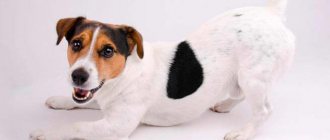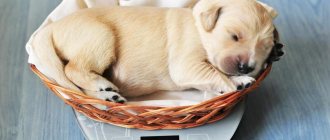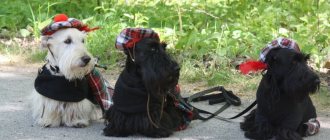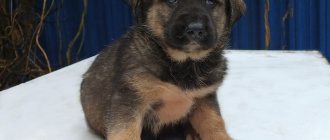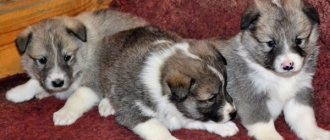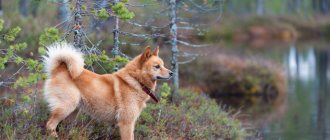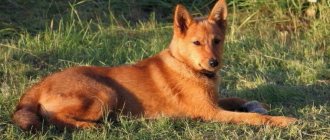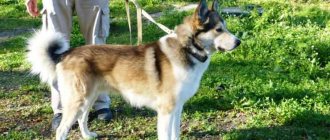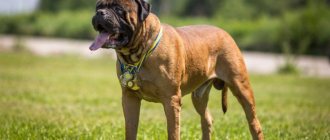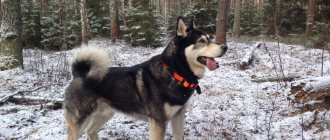Features of the East Siberian Laika dog breed
Hunting dogs have lived with humans since cave times. The pets helped with hunting and protected the home from outsiders. And over time, they became not only assistants, but also faithful comrades.
These species include the East Siberian Laika, which has not left humans for two thousand years. It is not only a hunting breed, but also a sled dog. The Vostochnik was bred using Amur and Evenki dog breeds. It is the largest of the huskies.
Health and diseases of East Siberian huskies
East Siberian Laikas are healthy dogs that do not have a predisposition to most hereditary diseases. The breed is not able to resist only viral diseases - distemper, enteritis and rabies, and it is working individuals who are most susceptible to them. The salvation from these problems continues to be timely vaccination - at 2-2.5 months puppies are already allowed to be vaccinated against canine distemper, and at one year - against rabies.
By the time of vaccination, the puppy must be wormed in advance - it is advisable to do this a couple of weeks before the procedure so that the body has time to recover. After vaccinations, the animal is quarantined for 14 to 22 days. He should be fed heavily, protected from hypothermia, and walked only in deserted places where there are no other dogs. And of course, do not forget that the vaccine will have to be administered repeatedly, and the pet should be treated with anthelmintic drugs throughout the life of the husky.
Origin of the breed
The ancestors of the modern husky are considered to be hunting dogs of Siberia. They were a priority for breeding among the local population engaged in hunting fur animals.
The number of AFL grew rapidly, but people could not domesticate all the animals due to their small population. This led to the fact that the animals became isolated and began to differ from each other in habits and external characteristics.
The first attempt to describe animals was made by researchers Shirinsky, Krestnikov and Liverovsky at the end of the nineteenth century. This did not lead to great success.
And only in the early eighties of the twentieth century, the famous Soviet dog handler A.V. Geits managed to describe this type of dog. To create a final species standard for the East Siberian Laika, which is used to this day by breeders and exhibition commissions.
How to choose a puppy
- If a puppy is purchased for hunting a specific animal, check with the seller what successes the baby’s parents have in this matter. For example, for elk hunting, it is better to take offspring from elk huskies and undesirable from easterners who work strictly on squirrels.
- The hunting ability of males and females of the East Siberian Laika is practically the same. However, male dogs often get lost in the forest because they are distracted by the smells of bitches in heat, which can be several kilometers away. Accordingly, if you are not ready to spend hours, or even days, searching for a lost dog, choose “girls”.
- Choose puppies from spring litters. Such babies are healthier because they grow and develop in the warm, sunny season.
- Check the age of the litter's sires. Breeding females of the East Siberian Laika are ready for mating at one and a half years, and males at two years. The offspring of too young parents, as well as those of too old parents, have poor health. It is optimal when mature and old males (6-10 years old) are bred with 3-year-old females and vice versa - young two-year-old males are mated with 6-9 year old huskies.
- Assess the general condition of the puppies. Sparse fur, a dry nose and signs of emerging rickets indicate that it will take a long time to nurse such a baby.
Appearance
The Oriental is distinguished by its endurance. Ideal for hunting. The dog is a large breed, with a well-built, slightly elongated body and powerful bones.
The adult species reaches a height of up to 64 cm with a weight of up to 23 kg. If you look closely at the dog's head, you can see a wedge-shaped shape. The skull is quite powerful with a rounded occiput. The length of the muzzle is equal to the length of the skull.
- The ears are located at eye level. They have a mid-rise, standing shape and are pointed or rounded at the end.
- The iris of the eyes has a brown tint. The eyes themselves are medium in size with an oval or oblique slant.
- The teeth have a scissor bite. They look large and well developed.
- Large nose with harmonious nostrils.
- The animal's neck is equal to the length of its head. She is strong and has large muscles.
- Strong and wide back. The withers are clearly marked.
- The tail looks like a hook. Raised to the back.
- Paws in the form of a lump. The limbs are hardy and straight.
Mating
Laiki is a breed of dog that has not been modified as a result of human selection. The reproductive function is preserved at the level of its ancestors - wild predators such as wolves, jackals: they are ready to mate once a year.
With the appearance of the first objective signs of estrus, the bitch is isolated from the males, preventing escape and accidental mating. At the same time, it is necessary to carry out measures to expel worms and treat the dog for fleas and ticks. Giving your dog anti-parasitic drugs after breeding can cause premature birth or deformed puppies.
On days 11-12 after the start of estrus, you can begin the process. But it’s better to observe the dog’s behavior. The main sign of a bitch’s readiness is that when stroking the rump, the dog stands calmly and moves its tail to the side. The second way to check is to let the dog down. If the bitch lets you sit, it means she is ready. At the same time, both huskies are kept on their leashes.
The meeting for the “newlyweds” is arranged in the morning, after a good walk. The bitch is brought into the dog's territory. East Siberian huskies mate on an empty stomach. Males usually breed on their own; sometimes you have to hold the bitch, especially if this is her first mating. If she is too aggressive and tries to bite the dog, then she is muzzled.
After mounting the male, mating occurs and lasts 15-35 minutes. At this time, the dogs cannot be separated, but on the contrary, every effort must be made so that the dogs do not pull in different directions. At the end of the mating, the bitch is taken away on a leash, not allowing her to urinate. Subsequent mating must be carried out every other day.
A completed mating of East Siberian Laikas is subject to mandatory registration with the hunting club.
Animal color
Upon careful examination of the wool of the Oriental, the following characteristics are given:
- The coat is abundant with a rigid structure;
- The area of the head, ears, legs with a predominance of short hair;
- The husky's neck and shoulders are covered with lush fur;
- The inside of the legs has moderate fur.
The main colors are presented in the list below:
- White;
- Redhead;
- Gray;
- Piebald;
- All shades of brown;
- Black and tan.
Attention! If in front of you is a brown, marbled, blue and black dog. This means that the breed is crossed with other species. All this is a violation of the standard.
Photos of the East Siberian Laika with its real color are presented in an open source.
Pros and cons of the breed
The East Siberian Laika will be an ideal pet for a person who lives in the countryside, enjoys hunting and has the opportunity to often travel with the dog into the forest and into nature.
The main advantages of VSL:
1. Innate hunting instinct. 2. Intelligence, quick wit. 3. Easy to train. 4. Suitable for aviary keeping. 5. Good health. 6. High performance, endurance. 7. Devotion. 8. Fearlessness.
Character of the East Siberian Laika
The Vostochnik is a very hardy dog. Before you start it, you need to think carefully about everything. Since the breed is not a couch potato and requires a lot of attention.
Experienced dog experts advise against purchasing an adult pet, because it becomes very attached to its old owner and may not accept new people. East Siberian Laika puppies are more suitable for purchase.
It must be remembered that the animal must first be raised by one owner, whom it will completely trust and obey. Laika treats other members of the household, and especially children, with trepidation and will never offend.
There have been cases when the Easterner was friends with cats and parrots, if these pets grew up together. It is necessary to keep in mind that the husky is still a hunting breed and keep rodents and other small animals away from it.
Advice! During a walk, do not allow the dog to come into contact with other individuals, as the dog may behave restlessly.
Hunting with the East Siberian Laika
Unlike Western Siberian Laikas, Eastern Laikas are not so popular among hunters in the Central Belt. The reason for the low prevalence of the breed is partly that its representatives are less passionate in their work than their relatives in the section. At the same time, VSL is distinguished by a large search breadth, high sensitivity and excellent viscosity. A valuable quality of East Siberian huskies is their ability to quickly adapt to changing realities. In fact, the animal is capable of hunting in any climatic zone, from taiga wilds to forest-steppe.
Like most huskies, VSLs are considered versatile hunters. However, the breed works best with elk, bear, wild boar and small mustelids. The dog's hunting technique consists of tracking an animal by scent, barking at it and detaining it until the owner arrives. The correct easterner follows the trail silently and speaks only when the game is in sight. Another feature of the breed is searching at a trot, turning into a gallop and, less often, into a walk. During field trials, the talents of commercial East Siberian huskies are assessed according to the following indicators:
- flair;
- speed and accuracy of search;
- voice;
- the nature of the barking (no hysterical screams, running or throwing at the tree where the squirrel is sitting);
- surveillance and viscosity (perseverance in finding and apprehending the animal);
- obedience;
- attitude towards killed prey (it is allowed to lightly bite the shot squirrel, but not tear it).
Each husky has its own hunting preferences. Accordingly, when acquiring a VSL, calmly accept the fact that the degree of enthusiasm for the process of catching trophies in different conditions will be different. For example, some dogs enjoy hardcore bear hunting, while others prefer going after moose. In addition, having tried to work “on a large scale”, East Siberian huskies lose interest in small fur-bearing animals and do not show much zeal in hunting squirrels.
Among hunters, it is considered undesirable to involve the East Siberian husky in hare hunting. Carried away by the pursuit of the oblique, the dog moves too quickly away from the owner and does not hear commands. As a result, the hunter does not have the opportunity to catch up with the pet, and the irritated dog independently deals with the prey, which is, in principle, unacceptable. For the same reason, it is not recommended to allow East Siberian huskies to roam uncontrollably through the forest in summer. On such unauthorized trips, the dog learns to hunt, strangle and eat light game such as young moose calves and hares, and then during the seasonal hunt it no longer adheres to the rules, spoiling the prey with its teeth.
How to care for a dog
Caring for an animal will not be difficult if you follow these instructions:
- For a comfortable life, a husky needs a home or an enclosure;
- The enclosure must be more than 8 meters in length and 2.5 meters in height with an insulated floor and a warm booth;
- Before reaching the age of one month, puppies cannot be separated from their mother;
- In just over a month, small pets are moved into an enclosure;
- VSL requires increased physical activity;
- During the molting period, the animal is combed daily using special means. The rest of the time - once every 2-3 days;
- It is necessary to keep a notebook of routine vaccinations. The life expectancy of the animal depends on this;
- In the summer, conduct a thorough examination of the skin of the husky for dermatitis and irritation;
- Wash twice a year with special shampoos;
- Claws are trimmed 2 times a month, if it is not possible to grind them down on their own;
- Ear care - with a disc moistened with warm water. The eyes are rubbed with chamomile infusion.
Maintenance and care
The East Siberian Laika is a dog with strong immunity and hardening developed at the genetic level, so experts recommend not taking even newborn puppies with their mother into a warm place, but keeping them in an unheated room. You can often hear stories about how easily Easterners adapt to apartment life. At the same time, keeping the breed in “greenhouse” conditions is not approved by breeders, and it does not benefit the animal itself. A healthy working dog is able to live in the yard, where a durable enclosure with a warm booth should be built for it, which is best installed on the sunny side.
Keeping a husky on a chain is acceptable as a temporary phenomenon until the enclosure is equipped. Moreover, the chain must be attached to a movable block, which will allow the animal to move freely around the yard. You need to take your puppy for a walk in crowded places after vaccination against distemper and enteritis. Before receiving vaccinations, it is also necessary to take the baby out to breathe, but in locations where contact with other dogs and people will be excluded. It is best to walk with your ward in forests and meadows, which is preparation for future hunting. The duration of promenades should be at least 2 hours a day, since the longer the puppy is in the sun, the less chance he has of getting rickets.
Hygiene
East Siberian husky puppies cannot be bathed at all. Adults should also not be washed unnecessarily, since the protective fatty lubricant is removed from the skin and coat along with shampoo and water. It is enough to wipe a dirty pet with a damp cloth, and rinse dirty paws in lukewarm water without using dog cosmetics. It is strongly not recommended to wash the East Siberian Laika on the eve of the exhibition, since the hair devoid of the fat layer looks less aesthetically pleasing and there is a risk of receiving a low score from the judges for exterior.
You need to brush your yard VFL twice a week during the shedding period and once a week at all other times. With apartment huskies, the frequency of brushing will have to be increased if you do not want the home to turn into a warehouse for wool. If the dog hunts constantly and productively, the “pedicure” of the claws can be neglected, since the plate is naturally worn down. Orientals, who travel to exhibitions more often than work, need to have their nails carefully trimmed. The East Siberian Laika's ears are checked after each trip to the forest or a couple of times a week if the dog spends time in the yard.
It is better to remove excess wax inside the ear specula with a cloth soaked in hygienic lotion. Mandatory measures include treating the fur against ticks and ectoparasites, as well as periodically boiling the mattress on which the animal sleeps. It is extremely important to monitor the health of the East Siberian Laika’s eyes and remove dirt from them with a clean cloth moistened with strong, chilled tea. If your eyes suddenly become red or watery, try applying tetracycline ointment to the lower eyelid. If there is no improvement within a couple of days, the husky will have to be taken to the veterinarian.
Feeding
Adults are fed twice a day, and during the hunting season the food is divided into unequal parts: in the morning the pet eats ⅓ of the daily requirement, in the evening, but not earlier than an hour after working on the animal, the remaining ⅔. As for any hunting dog, the basis of the diet for the East Siberian Laika is meat. In order to save money, everything obtained during the hunt is used - cut up squirrel carcasses, muskrat meat and entrails, as well as any other edible trophies. During active fishing activities, the share of animal food in the daily menu of the AFL should reach 600-800 g.
East Siberian huskies are unpretentious pets that do not need food variety. Along with meat, they can also be given cheaper products - sea fish, from which large bones have been extracted (can be minced), cereal porridges, offal, rye bread, curdled milk, chicken eggs, vegetables (except legumes), fruits, young greens. Some owners teach their pets to find edible fruits and eat them from the bush. In the future, if the dog gets lost while hunting, it will be able to feed itself for several days.
Mandatory products in the diet of East Siberian husky puppies are cottage cheese and cartilage tissue, without which the formation of a strong skeleton is impossible. The first complementary food in the life of an Easterner is liquid porridge with milk (semolina, pureed rolled oats). They are best given to one-month-old puppies. Six-month-old adolescents are allowed to include porridge from whole grains in the menu - rice, oatmeal, pearl barley. They are prepared in meat and bone broth with the addition of a small amount of salt, unrefined vegetable oil or fish oil, as well as vegetables - cabbage, carrots, pumpkin, zucchini. It is also useful to feed the growing VFL with sprouted oats and wheat. Unsalted cheese, butter, and rye crackers are suitable as an incentive treat. The source of the necessary vitamins can be dandelion leaves, nettle (scalded with boiling water), kelp or ready-made vitamin complexes from a veterinary pharmacy.
Important: East Siberian huskies are only allowed to be given river fish and liver that have been heat-treated, since these products are often contaminated with worms.
Dog food
The pet's health depends on the food supply. Laika prefers both natural and store-bought food.
If the breeder decides to feed the Oriental a natural diet, then the following products should be included in it:
- Beef of lean varieties;
- Boiled sea fish (2 times a week);
- Boiled offal;
- Cottage cheese;
- Kefir and yogurt (up to 4 months);
- Oats, rolled oats, rice, millet and pearl barley;
- Raw and boiled eggs;
- Carrots, cabbage and seasonal fruits.
An adult dog is fed 2 times a day. A serving consists of 400 grams of raw scalded meat, 100 grams of vegetables in any form, 150 grams of cereals and a little cottage cheese.
Attention! You can't give your husky tubular chicken bones!!! This can cause irreparable harm to health.
- The animal is treated regularly for worms.
- River fish is prohibited for the animal.
- Vegetables are healthier when eaten raw.
- Between seasons they provide minerals.
If the breeder decided to feed the pet with store-bought food. You need to inquire about the quality of this product. Experienced dog experts recommend the following types of food:
- Naw;
- Orijen;
- Go;
- Bosch;
- Hills.
Training
The animal must be trained by one owner or instructor, starting from 6 months of age. They are trained to catch the necessary game. AFL are excellent at hunting birds, small fur-bearing animals, and even bears.
Dog handlers recommend training children using the example of adult dogs. This way the likes will quickly understand what is wanted from them.
Another very interesting feature of this breed is that the puppies perceive their family as a pack. Therefore, one of the small pets may imagine itself as a leader. This cannot be allowed, otherwise there will be no obedience to the owner’s commands.
How can huskies get sick?
VSL, as a true Siberian, is not susceptible to disease, unlike other species.
If only the animal grew up in a nursery, then diseases such as:
- Plague;
- Rabies;
- Enteritis;
- Retinal atrophy;
- Cloudiness of the eye crystal and oral disease.
With good care and nutrition, huskies live up to 12-15 years.
Health
The average lifespan of an East Siberian Shepherd is 12-13 years ; with proper care and nutrition, representatives of the breed can live much longer.
By nature, VSL is endowed with strong immune protection and good health. She is hardy, able to survive in extremely harsh climatic conditions and rarely gets sick.
Most often, the East Siberian Laika has the following health problems:
- Injuries - occur mainly during hunting; a husky can be bitten, injured by a wild animal, or a dislocation or fracture can occur due to careless movements in the wild. In such unfortunate cases, the owner of a hunting husky must know how to provide first aid to the dog.
- Allergies – allergic reactions can occur in huskies to food and detergents. Based on this, you should be careful and gradually introduce changes to your pet’s diet, and also use hypoallergenic shampoo for bathing.
- Obesity - if you do not provide the VSL with the proper level of activity and allow overeating, a diet that is too high in calories, the dog will quickly gain excess weight, which is fraught with complications of the gastrointestinal tract and cardiovascular system.
The good health of representatives of the Siberian breed is not a reason for the owner to relax and ignore veterinary support.
VSL definitely requires deworming, as it feeds on raw meat and bones. Routine vaccination is necessary, since a hunting dog often comes into contact with wild animals and can become infected with infectious diseases, such as, for example, skaz and enteritis.
Once a year you should visit a veterinary clinic with your husky, where it will be examined by a veterinarian for preventive purposes. It is also recommended to undergo tests during such visits.
Where to buy (puppy price)
A beginner always faces the question: – Where to buy an East Siberian Laika? This breed is rare.
There are many advertisements for selling second hand, but there is a risk of running into scammers. Since puppies do not have characteristic differences at an early age.
List of verified nurseries:
- Ridge of Yakutia;
- Irkutsk Kennel of Hunting and Hunting Dogs.
The price for the East Siberian Laika starts from 20 thousand rubles. The price category depends on the purpose of the oriental: those trained for large animals are more expensive than sable hunters or squirrel hunters.
The detailed description of the East Siberian Laika breed presented above will help even an inexperienced breeder learn how to properly care for the animal and learn all the details of training.
After all, taking care of the acquired pet is the main thing for both the breeder and the dog. Which will repay for care and affection with loyalty and unshakable love for its owner.
Price of the East Siberian Laika
The average price tag for East Siberian Laika puppies is 15,000 - 20,000 rubles, if we are talking about offspring from planned matings, with a package of documents and from working parents with diplomas. The only caveat: you will have to literally hunt for the breed, since in the European part of Russia there are only a few breeders involved in breeding Orientals. The main population of VSL is concentrated in Siberia and the Far East, so get ready to ride through cities such as Irkutsk, Krasnoyarsk, Blagoveshchensk. The breed is also bred in the southern regions of the country - Voronezh and Belgorod.
